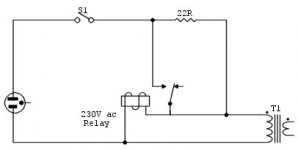In my recent amp I'm using 2 CL70 thermistors in series for a total of 30ohms when cold. It works pretty well, and there is no noise from transformer at start up. The secondary thermistors, used between capacitor's banks for extra filtering, make their contribution to fight inrush current as well.😉
Hi. If your concern is the lack of protection when the Inrush limiter is hot, then why not connect a Bi-metal cutout switch electrically in parallel with the inrush limiter. Connect the thermal switch to the heatsink near the output devices. If you chose an appropriate value for the switch, the time period you are not protected is minimal. I just use the inrush limiter and have not had a problem. Bill
Equilibrium said:If you didn’t mind flicking two switches, could you simply install a second switch after the power transformer?
Flick the first switch .... count to one .... flick the second switch.
yeh, i am doing the same with with my 1970's rotel amp - it gets annyoling and i would much rather have a automatic solution such as a thermister - especially since they cost about the same price as the switch
blank527 said:I'm thinking building one of these..
http://mitglied.lycos.de/Promitheus/delay_circuit_for_toroids.htm[/URL]
Any comments?
For me works very well. I've used it for a BOSOZ, SoZ (5.5W) and
a SE triode amp. For the SoZ I've used 22ohm resistor instead of 10Ohms. But my power comes from 220v main, I live in europe. Some people have reported problems adapting the circuit to 120V... so while I'm sure happy with it,
(sorry, a random click before being over...)
...I really can't recommend it light heartedly for anybody (120V countries). I still wonder why, thought.
ciao,
Roberto Amato
...I really can't recommend it light heartedly for anybody (120V countries). I still wonder why, thought.
ciao,
Roberto Amato
In response to Equilibrium, if your going to flip two switches why not leave the main supply on all the time and only turn on and off the second switch? Would it be dangerous to leave current running to the transformer all the time?
I don’t know, but it seems that every schematic I’ve seen places the power switch before the transformer and I just figured it was for a good reason. Otherwise why not simply place it after the transformer just like you suggested if doing so would fix the inrush problem? My guess is that you don’t want the power transformer “hot” 24/7, especially with no load on it.
I'd be interested if anyone could say why it wouldn't work. Would the transformer get hot when drawing no current?
I don't think so. It would just burn a few milliamperes... say 10-30 (dipends on quality) with a toroidal one of say 800VA due to internal losses. But this will not save you from inrush current of charging condensers... nor keep your amp circuits stand-by warm... so I don't really see a use for it.KenP said:I'd be interested if anyone could say why it wouldn't work. Would the transformer get hot when drawing no current?
ciao,
Roberto Amato
Is one type of inrush current any worse than the other? The inrush from the transformer could blow fuses, would the inrush to charge caps do the same thing? Could that inrush be taken care of with a delay circuit like the velleman k4700 kit?
Is this
not enough?
I think about using this circuit for my 500VA Toroid with 0,3F per channel.
Any Opinions if it would work on my Aleph5?
Regards,
Martin
not enough?
I think about using this circuit for my 500VA Toroid with 0,3F per channel.
Any Opinions if it would work on my Aleph5?
Regards,
Martin
KenP said:Is one type of inrush current any worse than the other? The inrush from the transformer could blow fuses, would the inrush to charge caps do the same thing? Could that inrush be taken care of with a delay circuit like the velleman k4700 kit?
As far as I know, transformer inrush, without a load attached does do nothing. Sometimes fuses blow because the device (with load) is turned off and then suddenly turned on; in this case the collapsing field in the transformer could crash against the AC voltage getting in, if by chance the AC is (in that istant) in opposing phase with the transformer field.
Conversely, a BIG charging condenser, especially the ones we love to use, always stress bridges, transformers and even home AC fuses (not just the device ones) if not properly tamed.
ciao,
Roberto Amato
- Status
- Not open for further replies.
- Home
- Amplifiers
- Pass Labs
- Aleph 5 inrush current protection

